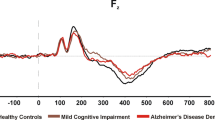Summary.
In Alzheimer’s dementia (AD) axonal disruption and cholinergic deficit lead to impaired cortical connectivity and to a decrease in EEG alpha coherence. The aim of the present study was to assess the usefulness of coherence parameters of the EEG for the diagnostics of AD. Quantitative EEG analyses were performed in 31 AD patients and 17 cognitively unimpaired depressive controls, both groups without psychopharmacological treatment. Differences between groups were examined and the diagnostic significance of EEG parameters was assessed by means of stepwise logistic regression analyses. In the AD patients global theta power was increased, left temporal alpha coherence and interhemispheric theta coherence were decreased. Left temporal alpha coherence and global theta power allowed an identification of AD patients with a sensitivity of 87% and a specificity of 77%. Quantitative analyses, especially the determination of left temporal alpha coherence, may enhance the usefulness of the EEG in the diagnostics of AD.
Similar content being viewed by others
Author information
Authors and Affiliations
Additional information
Declaration of interest: Eisai GmbH, Frankfurt, supported S.B. in part during the study
Received March 11, 2002; accepted June 10, 2002
Rights and permissions
About this article
Cite this article
Adler, G., Brassen, S. & Jajcevic, A. EEG coherence in Alzheimer’s dementia. J Neural Transm 110, 1051–1058 (2003). https://doi.org/10.1007/s00702-003-0024-8
Issue Date:
DOI: https://doi.org/10.1007/s00702-003-0024-8




